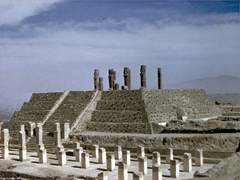| |
| |
|
| |
 Quetzalcoatl
established contact with the powerful Central American race
of the Toltecs, or Nagualecas; and, says Torquemada in a chapter
headed, "De la Poblacion de Tulla y su Senorio": Quetzalcoatl
established contact with the powerful Central American race
of the Toltecs, or Nagualecas; and, says Torquemada in a chapter
headed, "De la Poblacion de Tulla y su Senorio":
"They were men great in stature, excellent gold-and-silver
smiths. When they landed at Panuco, Quetzalcoatl was at their
head and they marched inland, under his direction. They built
the splendid city of Tullan, with fine and beautiful houses,
temples and palaces, all of greatest magnificence."
The Toltecs intermarried with the natives of the country,
and by command of Quetzalcoatl, colonized other parts of Central
America. Tollan, says the native historian Ixlilxochitl, was
a place of fine palaces and temples.
|
| |
|
| |
Eight leagues north east from Mexico City is the plain anciently
called the "Path of the Dead" (Micoatl). In it two
lagoons dedicated to the sun (Tonatiuh), and the moon (Metzli).
Hundreds of pyramids surround these lakes, forming streets
in dead-straight lines, running east west, north south. On
top of the Mexican teocallis - a truncated, or polled pyramid,
with a temple atop - stood two colosal statues, one to the
sun, the other to the moon. Plated of gold sheathed the stone
and the statues fairly dazzled the eyes. Naturally, the gold
hungry Castillian soldiers of Cortez stripped off the gold,
and the statues were destroyed by a fanatical Spanish Franciscan
priest, bishop Zumaraga, who broke every "idolo"
he could see.
|
| |
|
| |
In Anahuac was found the great Teocallis of Choluhuan. It
is described thus, in an unpublished Spanish manuscript by
Don Pedro de los Rios, written in A.D. 1556:
"In the interior was a square house, built of stone,
pillared with beams of cypress. It contained - in the beams
- two human skeletons, and there were idols of basalt, and
curiously painted and varnished vases. There was no outlet,
and the step work was of bricks. An altar at the top was dedicated
to the white bearded man Quetzalcoatl; but the Indians say
the pyramid was not originally meant to serve for the adoration
of Quetzalcoatl".
|
| |
|
| |
Quetzalcoatl, and other Atlanteans, were in the ancient dead
city of Palenque, Chiapas, the frontier state of modern Mexico,
but that ancient town with its palaces, temples, waterways,
bridges and pyramids existed long ages before the Mayas came
there. It is at the other famous Mayan town or dead city of
Chichen Itza, in Yucatan, well known to American archaeologists,
that there is found a significant memorial of Quetzalcoatl:
he is represented, in stone, as Atlas supporting the world.
And, as is known, Atlas gave his name to the drowned Atlantean
island-continent. Quetzalcoatl and the other men made the
Central American region so rich and fertile that it was said,
in an old Quiche chronicle: "a head of maize was a burden
for a strong man to carry".
Then there came a change in the spirit of the scene. The
time of the Great Catastrophe was drawing nearer.
continued....
|
| |
|
| |
|
| |
|
|
|